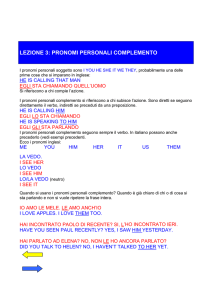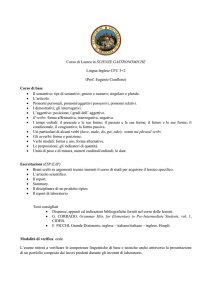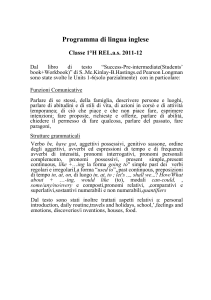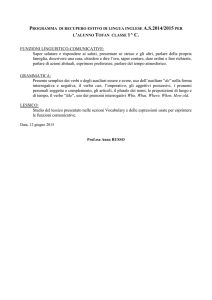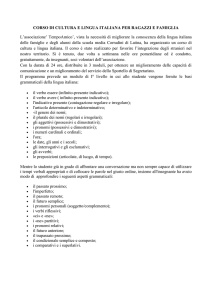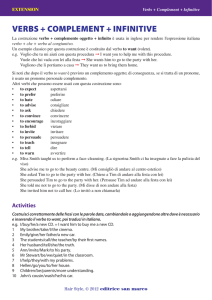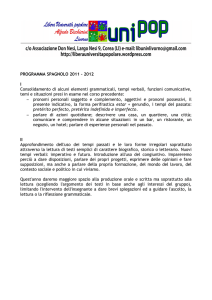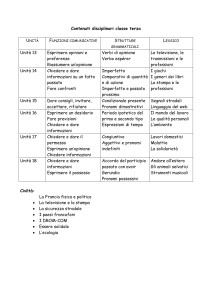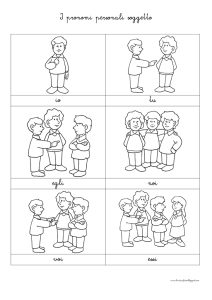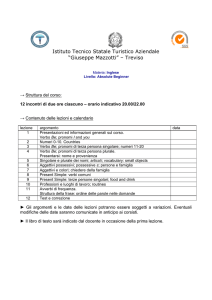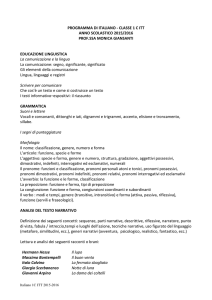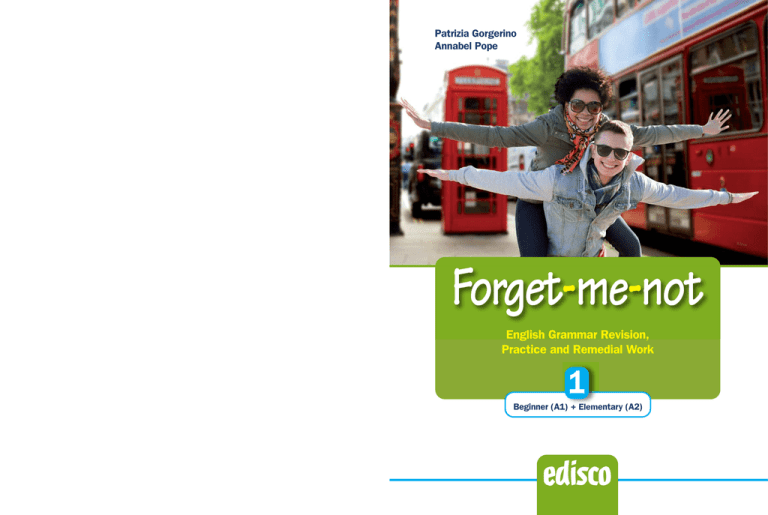
Patrizia Gorgerino
Annabel Pope
Forget-me-not
Forget-me-not
English Grammar Revision,
Practice and Remedial Work
1
Beginner (A1) + Elementary (A2)
Patrizia Gorgerino • Annabel Pope
Forget-me-not
English Grammar Revision,
Practice and Remedial Work
1
Beginner (A1) + Elementary (A2)
Forget-me-not • 1
Realizzazione editoriale:
– Progetto e consulenza: Manuela Barbero
– Progetto grafico: Manuela Piacenti
– Impaginazione: C.G.M. - Napoli
– Revisione testi: Lunella Luzi
In linea con le disposizioni di legge e le indicazioni ministeriali, si attesta che l’opera è realizzata in “forma
MISTA”, cartacea e digitale. L’Editore mette a disposizione gratuitamente sul proprio sito diverse risorse
didattiche online: materiali extra per attività di approfondimento e di esercitazione in parte ad accesso
libero e in parte riservati al docente.
L’opera è altresì disponibile in edizione DIGITALE per gli studenti diversamente abili e i loro docenti. L’Editore
mette a disposizione degli studenti non vedenti, ipovedenti, disabili motori o con disturbi speciici di apprendimento
i ile pdf in cui sono memorizzate le pagine di questo libro. Il formato del ile permette l’ingrandimento dei caratteri
del testo e la lettura mediante software screen reader.
Tutti i diritti riservati
Copyright © 2017 Edisco Editrice, Torino
10128 Torino – Via Pastrengo, 28
Tel. 011.547880 – Fax 011.5175396
e-mail: [email protected] • sito web: www.edisco.it
I diritti di elaborazione in qualsiasi forma o opera, di memorizzazione anche digitale su supporti di qualsiasi
tipo (inclusi magnetici e ottici), di riproduzione e di adattamento totale o parziale con qualsiasi mezzo
(compresi i microilm e le copie fotostatiche), i diritti di noleggio, di prestito e di traduzione sono riservati
per tutti i Paesi. L’acquisto della presente copia dell’opera non implica il trasferimento dei suddetti diritti
né li esaurisce.
L’Editore è a disposizione degli aventi diritto con i quali non gli è stato possibile comunicare, nonché per
eventuali involontarie omissioni e inesattezze nella citazione delle fonti dei brani, illustrazioni e fotograie
riprodotti nel presente volume.
Stampato per conto della Casa editrice presso
Stamperia Artistica Nazionale, Trofarello (To), Italia
Printed in Italy
Ristampe
5
4
3
2
1
0
2022
2021
2020
2019
2018
2017
PRESENTAZIONE
Forget-me-not è un supporto all’apprendimento della grammatica inglese,
che ripropone, sintetizza e rinforza la conoscenza degli argomenti strutturali
proposti nel testo di lingua. Esso può affiancare un testo di grammatica più
articolato, oltre che essere usato nelle attività di recupero o per svolgere i lavori
estivi.
• È organizzato in tre volumi, indipendenti l’uno dall’altro, che rispecchiano la
progressione nello studio della grammatica e i livelli di conoscenza della lingua:
– il primo volume tratta le strutture di base, corrispondenti al livello
beginner/elementary o A1/A2 del Quadro Comune Europeo di Riferimento
– il secondo volume affronta strutture più complesse, corrispondenti al
livello pre-intermediate o B1 del QCER
– il terzo volume completa l’esame degli argomenti grammaticali, fino a
coprire il livello intermediate o B2 del QCER.
Nel secondo e nel terzo volume sono talvolta ripresi argomenti (anche solo su
aspetti parziali) che riguardano un livello inferiore, sia per offrire allo studente
degli spunti per il ripasso e l’esercitazione, sia per la completezza della
trattazione di alcuni macro-argomenti importanti.
• Tutti e tre i volumi:
– sono suddivisi in macro gruppi tematici, all’interno dei quali sono
presentate le singole strutture
– si basano su un metodo induttivo: allo studente viene cioè chiesto di
completare un quadro normativo attraverso l’inserimento nel testo di
parole date in un riquadro iniziale. Questo compito obbliga lo studente
ad una lettura interattiva, non superficiale e distratta, ed attiva in lui dei
processi cognitivi che lo aiutano ad apprendere e memorizzare
– presentano alcune unità di lavoro che mettono a confronto due o più
strutture, che spesso creano difficoltà allo studente italiano
– propongono abbondanti esempi che rendono più chiare e comprensibili
le regole, con relativa traduzione in italiano
– presentano una sezione riassuntiva (round-up) alla fine del macroargomento, in cui lo studente deve puntualizzare gli aspetti principali di
tutte le strutture trattate in quella sezione, completando tabelle sinottiche,
anch’esse interattive ma prive dell’indicazione delle parole da inserire
3
– presentano un congruo numero di esercizi sia sui singoli argomenti che
nei round-up, proposti con un linguaggio semplice, della quotidianità, di
tipologia varia (scelta multipla, riempimento di spazi vuoti, trasformazione
di frasi, correzione degli errori, traduzione) in ordine crescente di difficoltà
– propongono nelle pagine degli esercizi degli aiuti linguistici sotto forma
di post-it con la traduzione da e in inglese dei termini meno comuni, in
modo che lo studente si possa concentrare sull’applicazione delle regole
e meno sulla comprensione del testo
– propongono esercizi contrastivi (segnalati dal simbolo C ) affinché lo
studente sia stimolato a ragionare e metta in campo tutte le competenze
linguistiche necessarie e non solo le capacità prettamente meccaniche e
compilative.
• Sono inoltre disponibili online delle batterie di test sia sulle singole unità
che sulla sintesi finale.
4
INDICE
M 0. Struttura della frase
...........................................................
7
M 1.
Pronomi personali e possessivi
U 1.1
Pronomi personali soggetto
....................................................................
8
U 1.2
Pronomi personali complemento . . . . . . . . . . . . . . . . . . . . . . . . . . . . . . . . . . . . . . . . . . . . . . . . . . . . . . . . . . . . . .
10
U 1.3
Aggettivi possessivi
..............................................................................
13
U 1.4
Pronomi possessivi
...............................................................................
15
.........................................................................................
17
Round-up 1
M 2.
Articoli e nomi
U 2.1
L’articolo indeterminativo
U 2.2
L’articolo determinativo
U 2.3
Plurale dei nomi
.......................................................................
18
.........................................................................
20
...................................................................................
24
Round-up 2 . . . . . . . . . . . . . . . . . . . . . . . . . . . . . . . . . . . . . . . . . . . . . . . . . . . . . . . . . . . . . . . . . . . . . . . . . . . . . . . . . . . . . . . . . .
26
M 3.
Tempi presenti e avverbi di frequenza
U 3.1
To be: present simple
............................................................................
28
U 3.2
There is - There are . . . . . . . . . . . . . . . . . . . . . . . . . . . . . . . . . . . . . . . . . . . . . . . . . . . . . . . . . . . . . . . . . . . . . . . . . . . . . . .
30
U 3.3
Present simple e avverbi di frequenza
.......................................................
32
U 3.4
Present simple: have got vs have
...........................................................
36
U 3.5
Present progressive
..............................................................................
40
.........................................................................................
45
Round-up 3
M 4.
Dimostrativi, partitivi e quantificatori
U 4.1
Dimostrativi: this, these, that, those
..........................................................
47
U 4.2
Aggettivi e pronomi partitivi . . . . . . . . . . . . . . . . . . . . . . . . . . . . . . . . . . . . . . . . . . . . . . . . . . . . . . . . . . . . . . . . . . . .
48
U 4.3
Quantificatori
......................................................................................
51
.........................................................................................
55
Round-up 4
M 5.
Aggettivi qualificativi, comparativi e superlativi
U 5.1
Aggettivi qualificativi
U 5.2
Comparativo di maggioranza
U 5.3
Superlativo relativo di maggioranza
Round-up 5
............................................................................
..................................................................
57
61
.........................................................
63
.........................................................................................
65
5
M 6.
Preposizioni e forma di possesso
U 6.1
Preposizioni di tempo
U 6.2
Preposizioni di stato in luogo
U 6.3
Altre preposizioni di stato in luogo
U 6.4
Preposizioni di movimento
U 6.5
Costruzione con of e genitivo sassone
Round-up 6
............................................................................
..................................................................
68
71
...........................................................
73
.....................................................................
75
......................................................
79
.........................................................................................
82
M 7.
Il passato
U 7.1
To be: past simple . . . . . . . . . . . . . . . . . . . . . . . . . . . . . . . . . . . . . . . . . . . . . . . . . . . . . . . . . . . . . . . . . . . . . . . . . . . . . . . . .
85
U 7.2
Past simple
87
U 7.3
Present perfect
.........................................................................................
....................................................................................
90
.........................................................................................
93
M 8.
Futuri
U 8.1
Future simple: shall/will . . . . . . . . . . . . . . . . . . . . . . . . . . . . . . . . . . . . . . . . . . . . . . . . . . . . . . . . . . . . . . . . . . . . . . . . .
96
U 8.2
Be going to . . . . . . . . . . . . . . . . . . . . . . . . . . . . . . . . . . . . . . . . . . . . . . . . . . . . . . . . . . . . . . . . . . . . . . . . . . . . . . . . . . . . . . . . . .
98
U 8.3
Present simple e present progressive con valore di futuro
Round-up 7
Round-up 8
.............................
100
.........................................................................................
102
M 9.
Verbi modali e verbi sostitutivi non modali
U 9.1
Verbi modali e sinonimi: caratteristiche . . . . . . . . . . . . . . . . . . . . . . . . . . . . . . . . . . . . . . . . . . . . . . . . . . . . . 104
U 9.2
Can e may
U 9.3
Must e have to
U 9.4
Could, might, should
U 9.5
Verbi sostitutivi non modali
...........................................................................................
Round-up 9
.....................................................................................
.............................................................................
106
108
110
....................................................................
112
.........................................................................................
114
M 10. Domande
U 10.1
Uso degli ausiliari nelle domande . . . . . . . . . . . . . . . . . . . . . . . . . . . . . . . . . . . . . . . . . . . . . . . . . . . . . . . . . . . . . 116
U 10.2
Domande senza wh-words e risposte brevi
U 10.3
Domande con la wh-word
................................................
118
......................................................................
120
Round-up 10 . . . . . . . . . . . . . . . . . . . . . . . . . . . . . . . . . . . . . . . . . . . . . . . . . . . . . . . . . . . . . . . . . . . . . . . . . . . . . . . . . . . . . . . . 124
Principali verbi irregolari
6
.....................................................................................
126
0
Struttura della frase
dopo • espresso • invariabili • l’inversione • luogo • nome • not • precede
• avverbi di quantità • segue • verbo
Nel formulare una frase in inglese bisogna tener presenti alcune regole di base:
n il soggetto deve sempre essere .................................., anche se è già stato citato in
precedenza, salvo alcune eccezioni
Robert is American. He lives in New York. Robert è americano. Vive a New York.
n nella frase affermativa e negativa il soggetto .................................. il verbo
John is American but he does not live in New York. John è americano ma non vive a New York.
n la frase negativa richiede l’uso della negazione .................................., che si colloca
.................................. il verbo be o l’ausiliare (a differenza del “non” italiano)
My cousins are not here. I miei cugini non sono qui.
They do not like computer games. Non amano i giochi al computer.
n la forma interrogativa richiede .................................. del soggetto, che si colloca dopo il verbo
be o dopo l’ausiliare
Is Mark a doctor? Mark è un medico?
Does he work in a hospital? Lavora in ospedale?
n gli aggettivi, tranne i dimostrativi, sono .................................., cioè hanno una forma unica
per maschile, femminile, singolare e plurale
a lively boy un bambino vivace; lively boys bambini vivaci
a lively girl una bambina vivace; lively girls bambine vivaci
n l’aggettivo
• precede il .................................. a cui si riferisce se è attributivo
What a beautiful flower! Che bel fiore!
• segue il .................................. (➝ be essere, seem sembrare) se è predicativo
These flowers are beautiful. Questi fiori sono belli.
n il complemento oggetto in genere .................................. immediatamente il verbo
Dan has a new car. Dan ha un’auto nuova.
n gli .................................. seguono il complemento oggetto (a differenza dell'italiano)
n in genere il complemento di .................................. precede quello di tempo
The class goes to the lab after break. La classe va in laboratorio dopo l'intervallo.
1
Riscrivi le seguenti frasi eliminando l’errore contenuto in ognuna di esse.
1. Valerie is from Wales. Has a flat in Cardiff. • 2. Is in the bookcase the dictionary? • 3. Are the students
not in class this morning. • 4. They not are at work today. • 5. Bob is going home? • 6. Is American your
friend? • 7. Jenny’s shoes are nices. • 8. What a day sunny! • 9. This book interesting seems. • 10. My
sister has next week an exam. • 11. She likes a lot pizza. • 12. We’re going tomorrow to the seaside.
0 • Struttura della frase
7
Pronomi
Struttura
personali
dellae frase
possessivi
I like cakes very much. Mi piacciono molto le torte.
1.1
Pronomi personali soggetto
cortesia • donna • dopo • esso/a • femminile • he • I • it • maiuscola • maschile
• negativa • plurale • seconda • she • soggetto • tempo • they • tu • you
FORMA
..............
io
you
..............
noi
.............. voi
.............. essi/e
we
egli
.............. ella
..............
it
..............
USO
n La prima persona singolare I è sempre scritta con la lettera ..................................
I am Italian. Sono italiano.
n La terza persona singolare ha tre forme:
• he per uomo o animale di sesso ..................................
He lives in France. Egli vive in Francia.
• she per .................................. o animale di sesso ..................................
She is very kind. Ella è molto gentile.
•
..................................
..................................
per cosa, animale di cui non si conosce il sesso, per parlare del
e per espressioni impersonali
What’s that? It’s a digital diary. Che cos’è quello? È un’agenda digitale.
It is hot and sunny in the south of Italy. Fa caldo e c’è il sole nel sud d’Italia.
It is five o’clock. Sono le cinque.
It’s very kind of you! È molto gentile da parte tua.
Pronomi personali e possessivi
n La terza persona .................................., invece, ha la forma unica they
They live in France. Essi/e vivono in Francia.
They are digital diaries. Sono agende digitali.
n You viene usato:
• per la .................................. persona singolare e plurale
You are a student. Sei uno studente.
You are late. Voi siete in ritardo.
• nelle forme di .................................. (corrispondenti al “Lei” italiano)
Nice to meet you, Mrs Grey. Piacere di conoscerLa, Sig.ra Grey.
8
Modulo 1
n Questi pronomi sono usati esclusivamente nella funzione di .................................. di una
frase e si collocano:
• prima del verbo nella forma affermativa e ..................................
We are at home. Noi siamo a casa.
They are not at the airport. Essi non sono all’aeroporto.
He doesn’t play football. Egli non gioca a calcio.
•
..................................
il verbo be o l’ausiliare nella forma interrogativa
Is she at the supermarket? È al supermercato?
Do they play tennis? Giocano a tennis?
1
1.
2.
3.
4.
5.
6.
7.
8.
9.
10.
Scegli la forma corretta del pronome personale corrispondente al soggetto della prima frase.
Bob plays the guitar. He/She/It/They plays the guitar.
That guitar is Mexican. He/She/It/They is Mexican.
The children are in their room. He/She/It/They are in their room.
Is Rebecca at school? Is he/she/it/they at school?
John is in his office. He/She/It/They is in his office.
His bike is new. He/She/It/They is new.
Pat and Chris are at the restaurant. He/She/It/They are at the restaurant.
Are your friends from Spain? Are he/she/it/they from Spain?
This computer is too old. He/She/It/They is too old.
Jane is cool. He/She/It/They is cool.
2
Completa queste frasi con i pronomi personali soggetto.
2.
3.
4.
5.
6.
7.
8.
9.
10.
..................... am very angry with him.
3
Riscrivi queste frasi usando i pronomi personali soggetto.
1. Jenny is going out with Paul. • 2. My sister and I often invite our
friends home. • 3. Are our neighbours at home? • 4. Is the book
interesting? • 5. Ted is talking to his Maths teacher. • 6. Are Laura
and Pat good friends? • 7. Do the children like horror films? •
8. Cabbages♦ and cauliflowers♦ contain vitamin C.
Why are ..................... so tired, Jeff?
Pedro is Spanish. ..................... is from Valencia.
Do you like this movie? ..................... is so slow!
They make great pizzas here: ..................... are crispy ♦. and tasty ♦.
Where is my satchel? – .....................’s over there, Mary.
Valery is not at school this morning. ..................... is not well.
How much are these pineapples♦? – ..................... are £2,00 each.
Mr Hudson is a surgeon. ..................... is in the operating theatre♦ now.
cabbage: cavolo
cauliflower: cavolfiore
crispy: croccante
operating theatre: sala operatoria
pineapple: ananas
tasty: gustoso
1.1 • Pronomi personali soggetto
9
Pronomi personali e possessivi
1. The Ferrers don’t live here. ..................... live in York.
1.2
Pronomi personali complemento
animale • complemento • cosa • dopo • femminile • her • it • me • plurale
• preposizione • them • unica • uomo • us • you (2)
FORMA
................
me/mi
................
him
te/ti
lui/lo/gli
................
lei/le
................
esso/essa/lo/la/gli/le
................
you
noi
voi
................
essi/e, loro, li, le
USO
n
Come per i pronomi personali soggetto, la terza persona singolare ha tre forme:
• he per ............................... o ............................... di sesso maschile
Henry’s school is far away. His parents always drive him there.
La scuola di Henry è molto lontana. I suoi genitori lo accompagnano sempre in auto.
• she per donna o animale di sesso ...............................
I didn’t hear Mary’s call. I must call her back.
Non ho sentito la telefonata di Mary. La devo richiamare.
• it per ............................... o animale di cui non si conosce il sesso
Look at your homework, John. Read it carefully and try to correct your mistakes.
Guarda il tuo compito, John. Leggilo attentamente e cerca di correggere gli errori.
n La terza persona ............................... ha la forma unica them
Pronomi personali e possessivi
I met the actors after the performance and spoke to them.
Ho incontrato gli attori dopo lo spettacolo e ho parlato con loro.
Cats chase mice and try to catch them. I gatti danno la caccia ai topi e cercano di prenderli.
n
La forma di cortesia è ..............................., come quella confidenziale
May I speak to you, Mrs Vaughan? Posso parlarLe, Sig.ra Vaughan?
n
I pronomi personali complemento solo usati nella funzione di ...............................
A differenza dall’italiano, hanno una forma ............................... e si collocano sempre
............................... il verbo
Where are my keys? – You have them in your bag. Dove sono le mie chiavi? – Le hai in borsa.
My sister is not in. Call her later. Mia sorella non è in casa. Chiamala più tardi.
n
Possono essere preceduti da una ...............................
She’s waiting for him. Lo sta aspettando.
10
Modulo 1
4
Scegli il pronome personale complemento corrispondente alle parole in corsivo nella prima frase.
1.
2.
3.
4.
5.
6.
7.
8.
9.
10.
I want to speak to your father.
Invite the Hudsons to the party.
Do you like pizza?
Can I have those biscuits, please?
Do you read the newspaper every day?
I must see Dorothy.
Look at that spider! What a big one!!!
Boys will play versus girls.
Meet Mr and Mrs Reagan.
Call Jane, please. Dinner is ready.
5
Scegli i pronomi personali complemento adeguati.
1.
2.
3.
4.
5.
6.
7.
8.
We’re going to the supermarket. Will you come with me/you/us?
Give me/you/them your email address, please. I’ll forward you all the information.
What’s your surname? How do you spell me/him/it?
My mobile number? I’ll write me/it/them for you.
Sorry, John. I can’t lend you/him/her my bike. I need her/it/them myself.
I need to speak to John. I’ll call you/him/her later.
Are your cousins here? Can we meet him/her/them?
Catherine is back from her holiday. I’m meeting him/her/them tonight.
6
Scrivi il pronome personale complemento (una parola unica) corrispondente alle parole in corsivo.
1. Can I speak to Mr Wynne, please?
.....................
2. They have invited James and me to dinner.
.....................
3. I often rent videos.
.....................
4. Can I have that sandwich, please?
.....................
5. Who is coming with you and Bob?
.....................
6. Mr Claxton will meet his daughter at the airport.
.....................
7. How often do you check your emails?
.....................
8. I can’t help Frank.
.....................
7
C
Scegli il pronome adeguato tra quelli proposti in corsivo.
Valerie Bresson is French. 1. He/She/Him/Her comes from Annecy but lives in Arles now. 2. She/
It/Her/They is a town in the south of France. 3. She/It/Her/They goes to a collège. Her father is
40 years old. 4. He/She/Him/Her is a barman. Her mother is 39. 5. He/She/Him/Her is a nursery
school teacher. Valerie’s brother doesn’t live with 6. her/him/us/them. 7. He/She/It/I works for a
travel agency in Avignon. 8. He/She/It/I sometimes meets Valerie and his parents. 9. He/She/Him/
Her goes to see 10. her/him/us/them in Arles when 11. he/she/they/them is free from work.
1.2 • Pronomi personali complemento
11
Pronomi personali e possessivi
him/her/it/them
him/her/it/them
him/her/it/them
him/her/it/them
him/her/it/them
him/her/it/them
him/her/it/them
him/her/it/them
him/her/it/them
him/her/it/them
8
C
Completa la seguente tabella.
PRONOMI PERSONALI SOGGETTO
PRONOMI PERSONALI COMPLEMENTO
I
.....................
.....................
.....................
he
.....................
.....................
.....................
it
.....................
.....................
.....................
you
.....................
.....................
.....................
Si collocano:
– ............................ nella frase affermativa e negativa
Si collocano sempre ............................ e
– ............................ il verbo be o l’ausiliare nella frase
interrogativa
possono essere preceduti da ............................
Pronomi personali e possessivi
9
C
Sostituisci le parole in corsivo con un pronome personale adeguato.
1.
2.
3.
4.
5.
6.
7.
8.
9.
10.
Bob is going out with Tricia.
Does Pauline work with Samuel?
Are your friends meeting our friends?
My sister and I always listen to this CD.
Nurse Ann is helping her patients.
Will your parents meet you and me at the station?
Does Mr Pritt always buy the newspaper?
Jennifer often drives her son to school.
The forks are in the top drawer ♦.
George and I are taking the 8.10 train to Liverpool.
10
Traduci le seguenti frasi in inglese.
Marcos è messicano. È sposato e ha due figli.
È una bella giornata di sole.
Vieni al cinema con noi!
Bob e Laura sono gemelli♦. Sono seduto vicino a loro in classe.
Non posso venire a Londra con voi.
Questi sono i miei esercizi. L’insegnante li controlla♦ tutti i giorni.
Maria fa l’insegnante. Lavora con me.
Non possiamo aiutarti.
Mi piace questo libro. – È interessante?
drawer: cassetto
Sei di Londra?
1.
2.
3.
4.
5.
6.
7.
8.
9.
10.
............................ ............................
............................ ............................
............................ ............................
............................ ............................
............................ ............................
............................ ............................
............................ ............................
............................ ............................
............................ ............................
............................ ............................
C
controllare: check
gemelli: twins
12
Modulo 1
1.3
Aggettivi possessivi
cosa • her • his • invariabile • its • my • our • plurale • possessori
• precede • terza • their • your
FORMA
................
mio/mia/miei/mie
................
tuo/tua/tuoi/tue
................
her ................ suo/sua/suoi/sue
your
nostro/nostra/nostri/nostre
vostro/vostra/vostri/vostre
................
loro
................
USO
n
Diversamente dall’italiano, la ........................................... persona singolare his/her/its
concorda con il possessore, e non con la ‘cosa posseduta’. Si usa:
• his se il possessore è uomo o animale di sesso maschile
Michael and his sisters are in London at the moment.
Michael e le sue sorelle sono a Londra in questo momento.
• ........................................... se il possessore è donna o animale di sesso femminile
Susan and her bother are coming here. Susan e suo fratello stanno venendo qui.
• its se il “possessore" è ........................................... o animale di cui non si conosce il sesso
The bird is in its nest. L’uccello è nel suo nido.
n
La terza persona ........................................... their si riferisce a più ...........................................
The Stevensons are driving to the airport to meet their guest from Italy.
Gli Stevenson stanno andando all’aeroporto in macchina per incontrare il loro ospite italiano.
Pronomi personali e possessivi
n
L’aggettivo possessivo, come tutti gli aggettivi attributivi:
• è ...........................................
This is my book. Questo è il mio libro.
These are my books. Questi sono i miei libri.
• ........................................... sempre il nome a cui si riferisce
You can use my bike. Puoi usare la mia bicicletta.
Here’s your umbrella! Ecco il tuo ombrello!
1.3 • Aggettivi possessivi
13
11 Completa queste frasi con his/her/its/their.
1.
2.
3.
4.
5.
6.
7.
8.
The spider is making ...................... web♦.
Mrs Wayne is scolding♦ ...................... students.
George and Sue often invite ...................... colleagues to dinner.
My cousin Fred is studying for ...................... History test.
They are going on holiday with ...................... friends.
James isn’t well. He’s calling ...................... doctor.
Caroline is going out with ...................... classmates.
Ted is doing ...................... homework.
12 Scegli l’alternativa corretta tra quelle date in corsivo.
1. Children, can I see your/my/their exercises?
2. How is his/her/your family, Mark?
3. Jennifer and her/his/their brothers are in London.
4. The bird is in his/its/their cage♦.
5. Henry is waiting for his/her/their girlfriend.
6. Are those his/her/your keys, dear?
7. Mario and Giorgio are going to the seaside for the day. His/Their/Its packed lunches are on the table.
8. Pamela and Tricia are meeting his/her/their colleagues at the cafeteria.
13 Completa queste frasi con gli opportuni aggettivi possessivi.
1.
2.
3.
4.
5.
6.
7.
8.
That is Henry and that’s ...................... cousin Tom.
Where are ...................... trainers, Mark?
May I introduce ...................... mother to you, Mr Brown?
The Simpsons are driving ...................... children to school.
A giraffe’s neck is long, but ...................... head isn’t very big.
The cat is licking ...................... whiskers♦.
We never do ...................... homework after dinner.
Mrs Child and ...................... husband live in Manchester.
Pronomi personali e possessivi
14 Cerchia R se il possessivo è corretto o W se è sbagliato. In questo caso correggilo.
1. She’s looking for hers keys.
R
W
......................
2. The letter is in her envelope.
R
W
......................
3. How old is your cat, Steve?
R
W
......................
4. Kathy and her brother are very noisy.
R
W
......................
5. James has invited their classmates home.
R
W
......................
6. I can’t find mys glasses.
R
W
......................
7. Mike is talking to her sister.
R
W
......................
8. The chocolates are in its box.
R
W
......................
9. Is this his wallet♦, Mr Halifax?
R
W
......................
10. Are these yours books, Jenny?
R
W
......................
14
Modulo 1
cage: gabbia
scold: sgridare
wallet: portafoglio
web: ragnatela
whiskers: baffi
1.4
Pronomi possessivi
articolo • donna • his • ours • possessore • theirs • uomo • yours
FORMA
mine
mio/mia/miei/mie
......................
tuo/tua/tuoi/tue
......................
/hers
suo/sua/suoi/sue
yours
nostro/nostra/nostri/nostre
vostro/vostra/vostri/vostre
......................
loro
......................
USO
n
Come per gli aggettivi, il pronome di terza persona
singolare concorda con il ................................... ed è:
• his se il possessore è ................................... o animale di sesso maschile
Where is James? These keys are his. Dov’è James? Queste chiavi sono sue.
• hers se il possessore è ................................... o animale di sesso femminile
Are these glasses Sheila’s? – Yes, They’re hers. Questi sono gli occhiali di Sheila? – Sì, sono i suoi.
Non si usa il pronome neutro di terza persona singolare
n
A differenza dell’italiano, ma in maniera analoga agli aggettivi, i pronomi possessivi
non vogliono l’...................................
These books aren’t mine. Questi libri non sono miei/i miei.
15 Completa le seguenti frasi con i pronomi possessivi, in modo che la seconda frase abbia lo stesso
significato della prima.
1. This is my pen. This pen is ............................... • 2. This is his computer. This computer is ............................... •
3. Are those your keys? Are those keys ...............................? • 4. Those aren’t their books. Those books
aren’t ................................ • 5. Is this your bike? Is this bike ...............................? • 6. That isn’t her videorecorder. That video-recorder isn’t ................................ • 7. That’s my cup of tea. That cup of tea is
................................ • 8. These are his jeans. These jeans are ................................ • 9. These aren’t our coats.
These coats are ................................ • 10. These are my suitcases. These suitcases are ................................
1.4 • Pronomi possessivi
15
Pronomi personali e possessivi
Il pronome possessivo non è mai accompagnato da un nome, in quanto lo
sostituisce
16 Scegli il pronome possessivo appropriato tra quelli dati in corsivo.
1. These comics aren’t mine/his/theirs, they are Bob’s. • 2. Welcome Mr and Mrs Thompson. Are
these suitcases♦ his/yours/theirs? • 3. Have you got an umbrella, Sheila? I left mine/yours/theirs
at home. • 4. Is this e-book his/yours/hers, Mrs Child? • 5. That bag’s Priscilla’s but the glasses
aren’t hers/yours/his. • 6. Can I use your pen, Jean? I can’t find yours/ours/mine anywhere. • 7. My
friend’s parents have bought this house and sold mine/his/theirs. • 8. Is this magazine♦ his/hers/
yours, Steve? – Yes, thanks. It’s mine/yours/his.
17
C
Completa la seguente tabella.
AGGETTIVI
PRONOMI
AGGETTIVI
PRONOMI
my
.....................
.....................
.....................
.....................
.....................
your
.....................
.....................
his
.....................
theirs
.....................
.....................
Gli aggettivi si collocano .............................
.....................
.....................
del ............................., i pronomi sostituiscono
.....................
.....................
il .............................
18
C
Riscrivi le frasi con gli aggettivi e poi con i pronomi possessivi, come nell’esempio.
Pronomi personali e possessivi
➤ This house belongs♦ to me. ➝ This is my house. / This house is mine.
1. This bike belongs to James.
............................................... / ...............................................
2. That house belongs to my grandparents.
............................................... / ...............................................
3. This car belongs to Henry.
............................................... / ...............................................
4. These papers belong to Caroline.
............................................... / ...............................................
5. Those satchels belong to the students.
............................................... / ...............................................
6. This iPad belongs to me.
............................................... / ...............................................
7. These sunglasses belong to her.
............................................... / ...............................................
8. That trolley belongs to him.
............................................... / ...............................................
19
Scegli l’alternativa corretta tra quelle date in corsivo.
1. Joseph is a doctor. What about her/hers/his cousin? • 2. Are your/yours/its friends coming here,
Fiona? • 3. Can I borrow your/yours/its bike, please? My/Our/Mine has got a flat tyre♦. • 4. We can’t
find our/ours/its passports. • 5. Whose homework is this? – I don’t know, it isn’t our/my/mine.
• 6. This scooter isn’t John’s. Its/His/Hers is black. • 7. Magdalene and
her/hers/theirs brothers are here. • 8. Your/Yours/His room is next to my/
our/mine, Steve.
20
Traduci le seguenti frasi in inglese.
1. Questo libro è mio e questo è tuo. • 2. Meg e suo cugino Ted sono molto♦
amici. • 3. Questa borsa è Sua, Signora Adams? • 4. Le nostre biciclette
sono in garage. • 5. A quest’ora guardano il loro programma preferito. •
6. Questi biblietti non sono nostri. • 7. A me piacciono i miei insegnanti, a Luca
non piacciono i suoi. • 8. Il pesce rosso♦ è nella sua vaschetta♦.
16
C
C
Modulo 1
belong: appartenere
flat tyre: ruota bucata
magazine: rivista
suitcase: valigia
molto (intimo): close
pesce rosso: goldfish
vaschetta: bowl
Round-up 1
Pronomi personali e possessivi
1
C
Completa la seguente tabella.
PRON. PERS. SOGG.
PRON. PERS. COMPL.
AGG. POSS.
PRON. POSS.
I
.....................
.....................
.....................
.....................
you
.....................
.....................
............... / she/...............
............./............./.............
............./............./.............
............. /his/–
.....................
.....................
our
.....................
.....................
.....................
.....................
.....................
they
.....................
.....................
.....................
2
C
Scegli l’alternativa corretta tra quelle date in corsivo.
1. They/It/Its isn’t Tom’s bike. He/Him/His is over there, next to me/my/mine. • 2. The teachers are
taking their/his/theirs students abroad. • 3. The Donovans have lost they/their/theirs cat and they/them/
theirs cannot find its/him/them anywhere. • 4. Will you come with we/us/ours if you/your/yours parents
let we/them/you? • 5. Will he/his/him invite she/her/hers to him/his/hers graduation? • 6. Jennifer is
waiting for she/her/his boyfriend. • 7. May I/me/my introduce I/me/my friend Frank Peck to you/your/
yours, Mr Sullivan? • 8. How long does it/its/they take you/your/yours to get home from here, Sandra?
3
C
Scegli l’alternativa corretta tra quelle date in corsivo.
Daniel Star is a Post Office clerk. 1. He/Him/His lives in Eastbourne, on the south coast of England,
with 2. he/him/his wife, Rebecca, and 3. they/them/their daughter Daisy, who is 4 years old. 4. She/
He/They goes to a nursery school, not far from the supermarket where 5. her/his/their mother works.
Daniel and Rebecca got married six years ago. 6. They/Them/Theirs have a nice house. 7. It/Its/They is
semi-detached ♦ and has a big front garden. 8. It/Its/Theirs back garden is smaller but nice.
4
Cerchia R se il pronome personale o il possessivo è corretto oppure W se è sbagliato. In questo
caso correggilo.
C
1. Mary and Steve are back from theirs holiday.
R
W ........................
2. Fiona is Paul’s girlfriend. She’s going to the cinema with he tonight.
R
W ........................
3. How long is the film? – I don’t know. I haven’t seen it.
R
W ........................
4. Can I have mine exercise-book back? I need it.
R
W ........................
5. Our friends are a bit rude these days.
R
W ........................
6. This can’t be Jane’s bag! Her is black.
R
W ........................
7. This is for you and this is for his.
R
W ........................
8. There’s a boy sitting in front of I.
R
W ........................
♦
5
C
Traduci le seguenti frasi in inglese.
1. Greta è tedesca. Vive a Berlino♦. • 2. Siamo stanchi. • 3. Essi la
ascoltano attentamente. • 4. Guardi la TV dopo cena? – Sì, la guardo tutte
le sere. • 5. Le mele sono sul tavolo. Puoi prenderle, per favore? • 6.
Maria e i suoi fratelli non sono a casa. • 7. Questo è il mio panino e quello
è il tuo. • 8. Il signor e la signora Simpson sono con la loro amica Laura.
rude: scortese
semi-detached: bifamiliare
Berlino: Berlin
17
Forget-me-not 1
■
Forget-me-not è un supporto all’apprendimento della grammatica inglese che
ripropone, sintetizza e rinforza la conoscenza degli argomenti strutturali già
affrontati nel testo di lingua. Può affiancare un testo di grammatica più articolato,
oltre che essere usato per le attività di recupero o per il ripasso estivo.
■
È organizzato in tre volumi, indipendenti l’uno dall’altro, che rispecchiano la
progressione nello studio della grammatica e i livelli di conoscenza della lingua:
● il primo volume tratta le strutture di base, corrispondenti al livello
beginner/elementary o A1/A2 del QCER;
● il secondo volume affronta strutture più complesse, corrispondenti al livello
pre-intermediate o B1 del QCER;
● il terzo volume completa l’esame degli argomenti grammaticali, fino a
coprire il livello intermediate o B2 del QCER.
■
Tutti e tre i volumi:
– sono suddivisi in macro gruppi tematici;
– si basano su un metodo induttivo per obbligare lo studente ad una lettura
interattiva, non superficiale e distratta, ed attivare in lui dei processi cognitivi
che lo aiutano ad apprendere e memorizzare;
– propongono numerosi esempi e un congruo numero di esercizi;
– presentano alcune unità di lavoro che mettono a confronto due o più
strutture;
– contengono una sezione riassuntiva con mappe che presentano in forma
schematica e/o tabellare i nuclei fondamentali delle strutture grammaticali.
Verifiche sommative
● Soluzioni per il Docente
●

